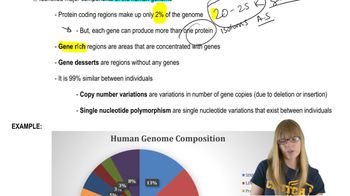Here are the essential concepts you must grasp in order to answer the question correctly.
Human Genome Size
The human genome consists of approximately 3 billion base pairs (bp), which encodes the genetic information necessary for the development and functioning of a human being. Understanding the size of the genome is crucial for grasping the complexity of genetic information and its implications in genetics, genomics, and evolutionary biology.
Recommended video:
GC Content
GC content refers to the percentage of guanine (G) and cytosine (C) bases in a DNA molecule. In the human genome, an average GC content of 40% indicates that 40% of the base pairs are either G or C, which can influence the stability of the DNA molecule and affect gene expression, mutation rates, and overall genomic architecture.
Recommended video:
Implications of GC Content on Genome Function
The GC content can have significant implications for various genomic functions, including replication, transcription, and the binding of proteins to DNA. A higher GC content often correlates with increased stability of the DNA double helix, while variations in GC content can affect the distribution of genes and regulatory elements, influencing evolutionary processes and adaptation.
Recommended video:
 Verified step by step guidance
Verified step by step guidance


